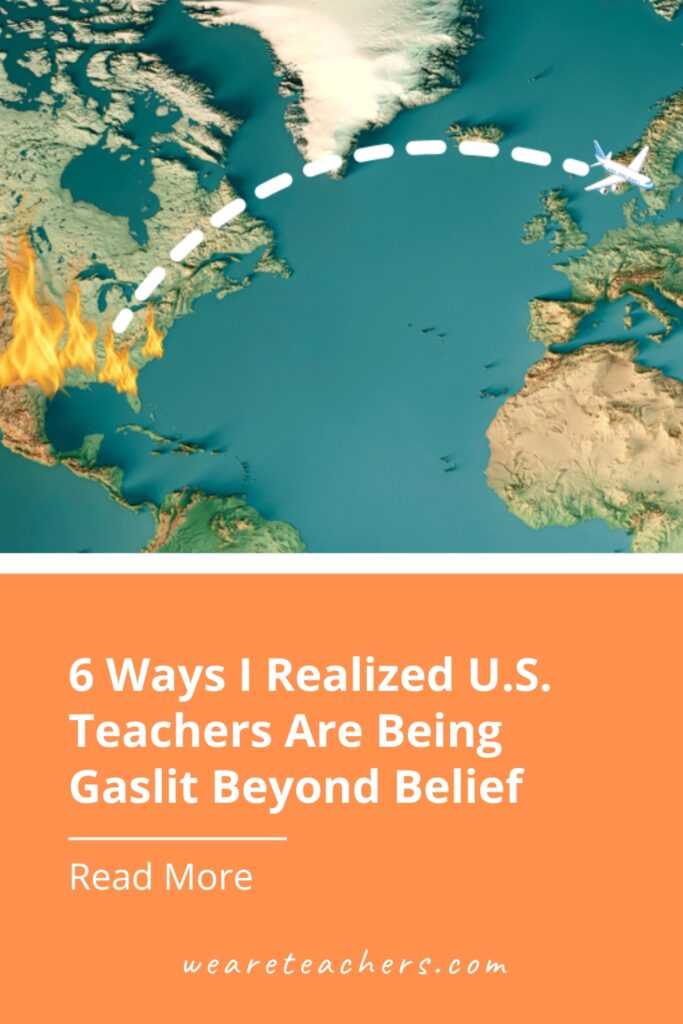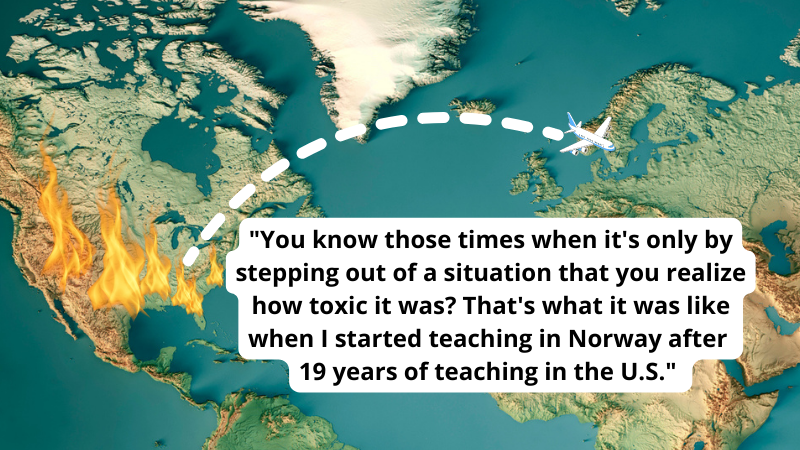You know those times when something seems off, but you think, “Maybe it’s just me. Maybe this is normal.” Then you step out of the situation and realize, “Aw, HECK no! That wasn’t normal—it was toxic!”
That’s what happened when I started teaching at an international school in Norway after spending 19 years as an Indiana public school teacher.
Ready to widen your perspective with me? Let’s take a look at “normal” parts of teaching in the United States that leave my colleagues here in Norway gasping in horror.
1. Teachers in the U.S. are “guilty until proven innocent.”
While teaching in Norway, I’ve encountered several hiccups. The time I caught several students cheating on an assessment. The time a student drew on a desk (and I didn’t catch it until much later). When a parent questioned an essential part of the unit.
In each situation, I slunk to my supervisor’s office and apologized, ready to be told off with Why weren’t you doing XYZ?
To my surprise, she responded, “You’ve done nothing wrong. There is nothing to apologize for!” and together we came up with our best path forward.
In the United States, I would likely have been scrutinized to see where I “contributed” to the situation. Years of having administrators, parents, and even elected officials second-guess our every move have conditioned us to doubt ourselves and our abilities.
Disrespectful students? “Build better relationships!”
Fight in the classroom? “Why didn’t you notice the tension building and defuse it?”
Students failing the class? “Adjust your expectations. These kids have been through a lot lately.”
Look, I’m all for taking responsibility for our classrooms, but expecting a teacher to control every detail of an entire classroom is—as my beloved grandma would have said—a bunch of horse pucky!
2. Teachers in the U.S. are shamed for taking sick days and needing childcare.
You know the drill. American teachers avoid taking sick days like … well, the plague (pun intended). But even on days when you absolutely, positively HAVE to take a sick day, it’s hard to heal because the guilt and pressure don’t let up.
However, when teachers here in Norway are sick, they stay home and—wait for it—rest! I’ve actually had my supervisor here tell me to take a day off instead of simply pushing through.
Even better, each parent here gets 10 days off per year to use when their child is sick or there’s a problem with daycare. And that is per parent! Solo parent or more than one kiddo? You get more days.
It’s like they actually understand teachers are humans and that they need to take care of themselves and their families.
3. Teachers in the U.S. are tasked with filling in the government’s gaps for their students.
During my first year here, I had a struggling student. While talking to the special education teacher (SpEd here includes social, mental, and emotional needs), I offered to have a heart-to-heart chat with the student. They responded, “Well, you can, but we have already put them in contact with mental health services, a counselor, and we are keeping an eye on them from a child-protection angle.”
I was shocked. You mean you actually have time and resources to help kids who are having a rough time? You’re saying that instead of being a social worker, therapist, and life coach all rolled into one that I can just … teach? Seriously?
Now, don’t get me wrong, Student services in Norway are still stretched thin, but there is a tremendous difference in the support level offered in the United States. Here, students dealing with family struggles, mental health issues, or other challenges have significant support from schools and government, including free dental care, prescriptions, and healthcare (which includes mental health).
Can you imagine how much easier it is to teach when kids and parents are supported like this? Let’s just say I spend a lot more time in my classroom teaching and a lot less time doing things that aren’t my job.
4. Teachers in the U.S. have very little protection against a toxic work environment.
As a coach for teachers transitioning out of the classroom in the United States, I hear horror stories about teachers being bullied by administrators, parents, other teachers, and even students. What I haven’t heard about is a reliable process for reporting bullying without involving a lawyer.
Here in Norway, harassment is illegal. That doesn’t mean it doesn’t happen, but there are specific channels to deal with it. Of course victims can receive support from their union, but they also have other channels with bullying, such as the Verneombud or a government tribunal.
Imagine having the ability to report an administrator or another teacher for bullying, and having the right to be heard without paying legal fees!
It goes further than just anti-bullying. It’s about the entire work environment being safe and healthy—from both a physical and emotional standpoint. The idea of subjecting students and teachers to constant active shooter drills while rejecting all attempts to regulate safe gun ownership is considered absurd here.
5. In the U.S., teachers have seen the weakening of unions.
When I started teaching in the United States way back in 1995, unions actually had some clout. It certainly wasn’t easy, but we had decent bargaining rights and could push back when administration was out of line. My, how things have changed! In the past 20+ years, unions have had their rights systematically stripped away until in at least five states, collective bargaining is not allowed by law, thus effectively nullifying unions.
Here in Norway, though, unions have a long and proud history. In 1942, the Nazis arrested hundreds of school teachers when over 12,000 of Norway’s 14,000 teachers refused to join the Nazi “teachers’ organization” and teach the proscribed Nazi curriculum. The teachers paid a heavy price, including some spending time in concentration camps, but they stood together. The Nazi curriculum was never taught in Norway.
Even as recently as 2014, four of five Norwegian teachers belonged to the union. The right to strike is still an important one throughout Norway, guaranteed by the Norwegian Supreme Court, and striking is relatively common.
6. The U.S. government has taken essentially no action to prevent school shootings.
I was just about to put the final touches on this article when the Facebook post of a colleague from Tennessee caught my attention. A week after the deadly shooting at the Covenant School, her legislators would not consider passing legislation to make schools safer. Instead, they were pushing to arm teachers and bring guns into more school buildings.
Teachers in the United States have been begging for protections—commonsense gun laws, more support with students who display violent tendencies—but nothing ever seems to happen, despite evidence that stricter gun laws work.
Interestingly, gun ownership is also common in Norway, which has the 10th-highest per capita gun ownership in the world. But gun violence isn’t common. In 2020, the United States had almost 20,000 gun homicides. Norway had two. Since the United States has a population about 60X that of tiny Norway, that would mean that Norway would have 120 if it had an equivalent population.
You read that right. 20,000 vs. 120.
Why? Well, possibly because Norway has strict regulations for owning a gun. You can’t buy a gun simply because you want to own one. You have to give a specific reason, such as hunting or shooting sports. If you give sport as the reason, you have to demonstrate regular attendance at a shooting club AND have a letter of reference from an officer of the club. Additional steps include a stringent background check and 30-hour training course. Plus, with conviction of even a minor crime, you risk losing your license.
Why It Matters
- It’s not just you. You’re made to think you have no power and don’t deserve a decent quality of life. This couldn’t be further from the truth.
- We can’t let negative treatment define us. As professionals, we deserve to be treated with dignity and respect.
- If it can be done elsewhere, it can be done in the United States. Does the teaching system in Norway sound better than it is in the United States? If so, we can change it. Not overnight, and not without a struggle. But slowly we can turn the tide and make education better for teachers. Which is, of course, the best way to make education better for students too.
- We teachers have more power than we think. Many U.S. states have made it illegal to strike, and a lot of teachers fear losing their jobs for even small work actions. But the Norwegian teachers stood together against the corruption of our profession, and we can too. Take back your power in whatever big or small ways you can.
- Most importantly, believe in yourself and the incredible beauty and power of our profession. Perhaps more than any other, our vocation has contributed to the advancement of humanity. Even if it seems like no one else notices at the moment, that’s a legacy I’m proud to be a part of!
What do you think is the biggest thing we could learn from the way Norway treats its teachers? Let us know in the comments!
Plus, for more articles like this, be sure to subscribe to our newsletters.


